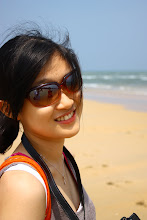It was a two days program organised by the Korean Culture and Information Service (KOCIS) to let the non-Koreans have an opportunities of exploring the UNESCO world heritage in Korea.
This time, we were brought to Yeongwol, a city which is about 3 hours away from Seoul.
Yeongwol is a nice town where it holds one of the most beautiful Royal tombs of the Doseon Dynasty,
--> the Jangeneung tomb of King Danjong
We departed from Gwanghuamun Square at about 830am.
The organising committees gave us a snack pack each as our breakfast I guess.
After 3 hours of journey, we finally arrived at Yeongwol.
Lunch was served in a restaurant. The side dishes were really different from Seoul.
Most of them are pickled vegetables which taste either sour or bitter.
Hence, most of us ate only the assorted mushrooms stewed beef.
We started the tour immediately after lunch.
Apparently the tomb located right in front of the restaurant.
Jangneung is the tomb of Kind Danjong (A.D. 1452-1455), the 6th King of Joseon Dynasty.
King Danjong ascended to the throne at the age of 12 after his father King Munjong died.
Soon after, he was dethroned by his uncle, Suyangdaegun 3 years after his ascension and ordered to be put to death by poison.
After many years, Kind Danjong was restored to the throne in 1698.
Thus the tomb is renamed as the Royal Tomb of Jangneung.
The Royal Tomb of Jangneung was listed as historical site no.196 in 1970 and later a UNESCO world heritage site on 2009.
There were a lot of butterflies flying around.
I am so glad that they were just butterflies but not bugs.
We had a tour guide to explain about the tomb.
He is indeed someone who specialised in history and had written books about this King Danjong.
Alongside, we also had a beautiful interpreter who constantly translate everything in English for us.
We are all giving a ear piece and they could just speak through the mic.
Thus, we had no problem understanding the history throughout the whole visit.
According to the specialist,
royal graveyard is usually divided into 3 parts:
The entrance, ceremonial and burial areas.
Each area has a different function and symbolic meaning.
The preparation area for the ancestral rites.
The red spike gate (Hongsalmun) symbolised the entrance to the shrine.
As you can see, there is a stone pathway which is divided into two.
The higher path and a lower path.
The higher path is for the God (Seondo).
There is even a signage stating it.
So here is some information about the Jeongjagak Pavillion.
Not only does the walkway has differences, even the stairs are different too.
The upper left is for human, the lower right is for the God.
Before heading up to the tomb, there is a little story to be tell here.
This is Eom Heung-do Jeongyeogak.
This pavillion was built to praise Eom Heung-do's fidelity.
When Eom Heung-do was a governor of Yeongwol, King Dajong was exiled then killed on 1457.
Kind Dajong's body was then left to float down the river and royal announced that whoever save the body of Danjong will be punished for three generations.
Despite the announcement, Eom Heung-do recovered the body of Dajong and gave it a secret burial.
That is why he was honoured as a loyalist.
There is a small hike up the hill before reaching the tomb.
The scenery up there was beautiful.
After visiting the tomb, we then head to the place where King Danjong was exiled to,
Cheongyeongpo.
The weather was crazily hot.
The staffs were nice enough to buy us ice popsicles.
We felt like a kid all over again eating them.
King Danjong was exiled to a small island.
It is a dense forest of pine trees.
The island was surrounded by deep river which can only be accessed by ferryboat.
After that, we headed to Gangneung, which is another 2.5hours away from Yeongwol.
On the next post, I will talk about the Gangneung Danoje Festival.
Stay tune.
































